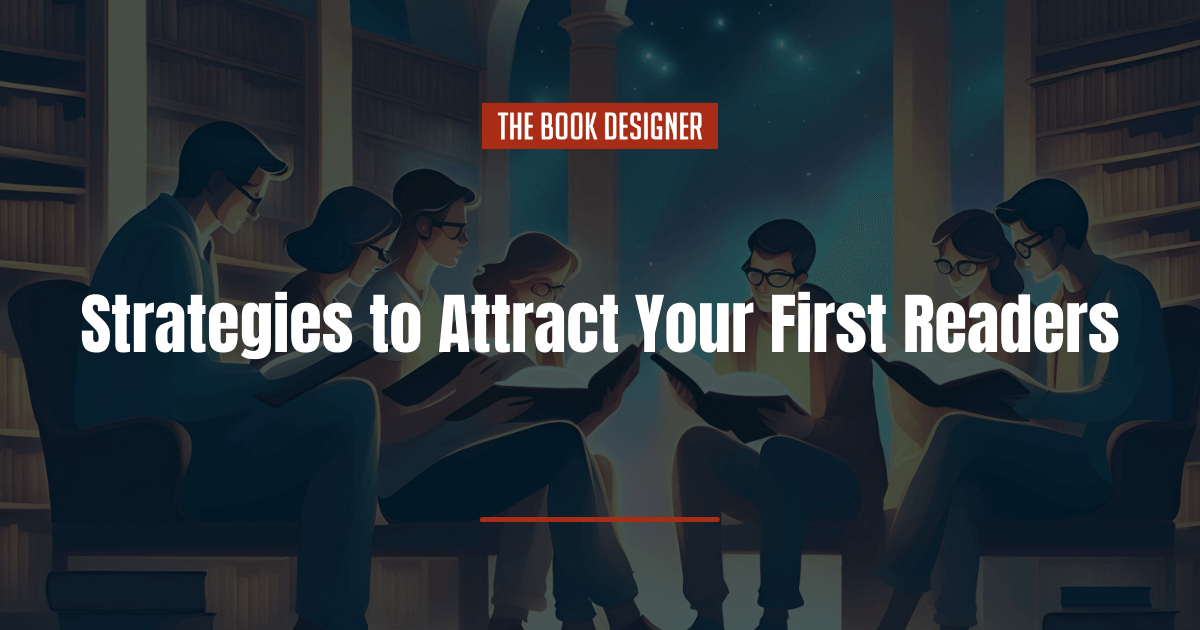Standing out as a newly self-published author can be challenging even for the most gifted writers. How do you find your first readers? How do find enough of those readers to actually make your self-publishing career financially viable?
It seems like if you ask ten successful self-published authors how they got there, you’ll get ten different answers. There isn’t a single path to success, and what works for one author won’t necessarily work for another, especially if they’re not working in the same genre or writing for the same target audience.
But without readers, you’ll quickly find your self-publishing dreams dashed. After all, does a book even exist if no one reads it? And if you want to make an actual living with your books, you don’t just need a few hundred readers; you need at least 10,000 who are consistently buying your books.
When finding your first readers, you’ll want to utilize strategies such as:
Reach Out to Your Network
If you’re a writer, in all likelihood you know people who read books. This is the best place to start when it comes to finding your first readers. Be sure to let your friends, family, and professional contacts know about your book (depending on your genre, of course), and ask them to pass it along to their friends and colleagues.
Make sure you’re letting your social media networks know, too. As soon as you start the self-publishing process, you should start promoting your book on social media. Let people know when it will be available and consider offering pre-orders for your book. And then be sure to promote it regularly once it’s released.
If you have an email list, be sure to announce your book there, too. I suggest sending an email announcing the book before it’s published, and then another one as soon as it’s available.
Optimize Your Book’s Online Presence
If you really want to make your book stand out, treat it like a brand. After all, that’s what it is. Your book’s brand, though, is really a sub-brand of your author brand. And your author brand starts with your online presence.
You’ll want to be sure to create a compelling author website that showcases each of your books (it’s okay to start with just one). Make sure that potential readers immediately know what your books are about and why they should read them. And then make it easy for them to purchase from their bookseller of choice.
When creating your author website, be sure to take utilize keywords and other SEO strategies so that your site pops up in relevant searches. Basic SEO for authors isn’t that hard to get the hang of and when done well can really pay off.
Leverage Book Platforms
There are a couple of book platforms you’ll definitely want to make sure you’re present on. The first is Amazon Author Central, which is the equivalent to an author page on Amazon. It will be linked from all of your books (click on an author’s name next time you’re browsing Amazon to see an example), and in turn it links to all of your books.
Author Central has a few features useful for authors beyond just listing your books. You can add your author bio that details your expertise as well as adding photos. And it allows your first readers and all that come after to follow your page for updates.
The other book platform you’ll want to check out is Goodreads. Goodreads is a Mecca for readers and makes it easy for them to find and talk about books. It also has space for book reviews and for readers to keep a list of books they want to read. And there are opportunities for authors to connect directly with your potential first readers through forums.
Be sure that all of your books are listed on your author account and that they link out to sites where readers can purchase them. Then take some time to engage with readers there to build an audience. Just remember to create actual connections and don’t just constantly self-promote.
Utilize Book Influencers, Bloggers, and Professional Reviewers
Book bloggers can have a surprisingly outsized influence on sales for many self-published authors. A feature on a popular book blog focusing on your genre can give you a noticeable sales boost and even propel you onto the Amazon bestseller list in your genre. And a positive review can have an equally large impact.
Influencers have expanded beyond book blogging, though. BookTok is now a hugely popular section of TikTok’s app, to the point that major bookstores are now devoting displays to titles that are trending on BookTok. If you can form relationships with those in the BookTok sphere, and one of them mentions your book, it could immediately boost sales and readership.
That said, don’t expect to just waltz into the BookTok conversations on the day you publish and get a warm reception. Social media is about building relationships, which means you need to start engaging with people there in authentic and genuine ways months before you ever release your book. That said, there are also opportunities for sponsorships and paid features on both TikTok and Instagram, but be prepared to pay for access to the most popular influencers.
You can also offer free copies of your book in exchange for honest reviews, but know that legally reviewers have to disclose that they got the book for free. These early reviews are crucial, though, as your first readers are more likely to take a chance on a new author if they have positive reviews.
Don’t Forget About Email Marketing
Before you publish your book, be sure to start building an email list. One way to do this is to offer a sneak peek at your book’s content in exchange for reader email addresses. Many authors offer the first chapter or two of their book when readers sign up for the newsletter list.
From there, be sure to send out regular updates and announcements. Be aware that emailing every day is often frowned upon, but that you should be consistent in sending out updates either a few times per week or even per month.
Consider utilizing Substack for reaching more readers. It’s become a popular newsletter platform for authors in all kinds of genres, and even provides an opportunity to earn more income through paid subscriptions.
Attend Book Fairs and Events
Attending book fairs and other local events is a great way to build a readership. Often, local bookstores love to host book launch parties or readings of authors from their area. And usually all it takes is reaching out to them about hosting an event.
Beyond that, there are trade shows and other book events that take place regionally or nationally. Attending can be a great way to network with others in the industry, including bookstore buyers.
Don’t be afraid to think outside the box, too. Let’s say that you write horror novels. Are there Halloween-themed events in your area where you could set up a booth to vend? If you write cookbooks, maybe there are food-related events you could sell your books at. Consider where your readership will be and then look into vending at those events. Even if you don’t make a huge number of sales, they can be a great way to get more exposure for your book.
Consider Offering Limited-Time Promotions
Limited-time promotions can be an amazing way to boost your readership. Amazon’s KDP Select program allows authors to make their ebooks available for free or at a discount for a limited amount of time each quarter. A free book offer can quickly boost your “sales” enough to land you on Amazon’s bestseller list, which can mean more sales once the promotion is over.
Offering free copies in book giveaways on social media can be another great way to boost your potential readership. And consider giving everyone who enters a download of the first couple of chapters even if they don’t win. The key to these promotions is to ask people to share your content or tag others who might be interested.
Encourage Reader Reviews and Referrals
Asking your first readers directly to review your books on platforms like Goodreads or Amazon offers social proof to other potential readers. How often have you bought a book (or any other product) on Amazon if it had no reviews? Probably not often, if ever. Getting those early reviews can make or break your book’s success.
Encourage your readers to recommend your book to their friends, too. Referrals are an excellent way to build word-of-mouth marketing and can lead to a surprising number of consistent sales as more people read and continue to recommend your book.
Final Thoughts on Gaining Your First Readers
Launching your book into the world as a self-published author can be a thrilling but challenging endeavor. The key to success lies not just in the quality of your writing, but in your ability to connect with and attract your first readers. Building a readership is a gradual process, one that requires dedication, creativity, and a strategic approach.
In this comprehensive guide, we’ve outlined various strategies to help you find your first readers and cultivate a loyal audience. Leveraging your existing network, optimizing your book’s online presence, and engaging with book bloggers and reviewers are fundamental steps in this journey. Social media marketing, email outreach, and active participation in author communities further enhance your book’s visibility.
Remember, this process is ongoing. Cultivating a readership is not just about attracting readers for one book but establishing a connection that lasts throughout your writing career. Your words have the power to resonate with readers, and by employing these strategies, you’re giving your book the chance to shine in the vast landscape of self-publishing.




